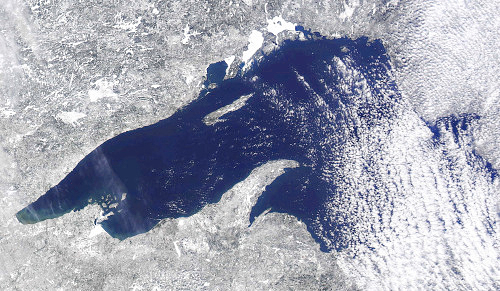Was 2012’s winter a sign of global warming?
While a year is not a trend, researchers analyzing temperature trends are pointing to the wide spread of higher temperatures as one indicator of global climate change, which would have a significant impact for the Great Lakes region.
What a winter 2011-12 has been! Or, was it a non-winter? Temperature readings tied or set records at some locations around Michigan as far back as 1913. So far, March’s heating degree days are 40% lower than normal. A trend is not seen in one year’s or even a few years’ data, but researchers at Potsdam Institute for Climate Impact Research (PIK) in Germany report that between March 13 and March 19, historical heat records were exceeded in more than 1,000 places in North America. The authors of the report, reported in the journal Nature Climate Change and summarized in the Eurasia Review, argue that the increase in statistical extremes throughout Europe, Russia, Asia and North America, mean that the climate is changing, what many often refer to as "global warming."
What are likely to be the effects of climate change for our region? Considering climate, the term for longer-term weather as opposed to annual summaries, the trends seem to be for more of a pattern similar to this year -- warmer winters, earlier springs, later falls. Though we didn’t see this in all areas of Michigan this year, we can expect wetter conditions, with more precipitation as rain and less as snow, according to David Lusch, Michigan State University Department of Geography and the Institute of Water Research senior research specialist.
 Lusch summarized work using 23 global climate models using internationally accepted guidelines and applied to a nationally accepted model for lake level and hydrological forecast. Researchers James Angel and Kenneth Kunkel developed three scenarios for forecasting—a low level, medium level and high level of greenhouse gas (GHG) emissions. In all three scenarios, air temperatures are likely to continue increasing this century, total annual precipitation will also likely increase and more variation around extremes will likely become more common. According to Lusch, more recent research using a high GHG emission rate, confirmed the high rate scenario of Angel and Kunkel.
Lusch summarized work using 23 global climate models using internationally accepted guidelines and applied to a nationally accepted model for lake level and hydrological forecast. Researchers James Angel and Kenneth Kunkel developed three scenarios for forecasting—a low level, medium level and high level of greenhouse gas (GHG) emissions. In all three scenarios, air temperatures are likely to continue increasing this century, total annual precipitation will also likely increase and more variation around extremes will likely become more common. According to Lusch, more recent research using a high GHG emission rate, confirmed the high rate scenario of Angel and Kunkel.
Weather system changes:
- More precipitation may fall as rain and less as snow.
- Intensity of precipitation events may increase.
- Potential evapotranspiration will increase with warmer air temperatures.
- The frequency of both droughts and intense rain events may increase.
- Summer and fall low flows in streams may be lower and last longer.
- Peak flows in streams may increase due to extreme precipitation events.
- Groundwater recharge and levels may decrease:
- More of the total annual precipitation may come during intense rain events.
- The infiltration capacity of many soils may be exceeded more frequently, generating more runoff and less infiltration (recharge).
Also, winter ice on the Great Lakes has diminished precipitously in the past 40 years, which may increase winter evaporation from the lakes.
Many scientists and meteorologists concluded some time ago that global climate change is occurring. The only contentious debate seems to be about whether the current warming is part of a natural cycle, with natural causes, or due to mankind’s impact, such as through heavy greenhouse gas (GHG) emissions starting with the industrial revolution in the mid-eighteenth century.



 Print
Print Email
Email


